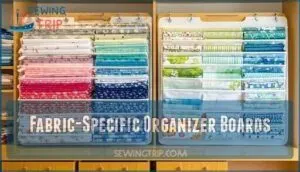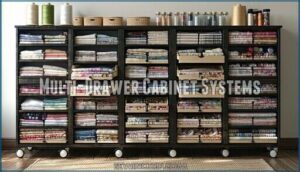This site is supported by our readers. We may earn a commission, at no cost to you, if you purchase through links.

Store everything in clear containers away from sunlight and humidity. Sort by color or fabric type for quick project hunting. Use breathable covers like cotton sheets to protect against dust and pests.
Don’t skip the labels—trust me, you’ll thank yourself later when you’re hunting for that perfect blue you swear you had somewhere. Take time every few months to go through your stash and donate pieces you’re never going to use.
The real game-changer is treating different fabrics differently—what works for cotton won’t work for silk.
Table Of Contents
- Key Takeaways
- Assess Your Fabric Collection First
- Choose The Right Storage Method
- Best Storage Containers and Solutions
- Creative DIY Fabric Storage Ideas
- Organize Fabric by Category or Color
- Protect Fabrics From Damage
- Smart Fabric Scrap Storage Solutions
- Label and Track Your Collection
- Maintain Your Storage System Long-Term
- Maximize Small Space Storage
- Frequently Asked Questions (FAQs)
- Conclusion
Key Takeaways
- Start by counting your fabric stash and measuring your storage space – You’ll need to know exactly what you’re working with before choosing the right storage containers and methods that actually fit your collection and room.
- Match your storage method to your fabric types – Fold cotton quilting fabrics to prevent stretching, roll knits and delicates to avoid wrinkles, and hang heavy fabrics with proper support to maintain their shape.
- Use clear containers and protect from damage – Store everything in transparent bins away from sunlight and humidity, then cover with breathable materials like cotton sheets to prevent dust and pest damage.
- Label everything and maintain your system regularly – Create a clear labeling system with fabric type, yardage, and project ideas, then schedule monthly decluttering sessions to keep your collection manageable and organized.
Assess Your Fabric Collection First
Before you choose any storage solution, you need to know what you’re working with. Take stock of your entire fabric collection and measure your available space to find storage methods that actually fit your needs.
Inventory Your Current Stash
Start your fabric stash management by conducting a thorough fabric audit. Pull everything out and face the reality of your collection. This needs assessment reveals your usage habits and helps with future project planning.
- Count total yards and pieces in your fabric collection
- Note which fabrics you’ve never touched (be honest!)
- Identify your most-used colors and patterns
- Calculate your stash size compared to storage space
Identify Fabric Types and Weights
Now separate your fabric stash by material composition and weight considerations. Cotton quilting fabrics behave differently than stretchy knits or delicate silks. Use a fabric type guide to identify textile properties like fiber content and drape.
Group lightweight cottons together and keep heavy canvas separate. This fiber identification step prevents storage mishaps. You wouldn’t store wool with synthetic blends or mix jersey with woven textiles.
Measure Available Storage Space
Before diving into fabric storage solutions, grab your measuring tape and check your room dimensions. Note your vertical potential from floor to ceiling.
Consider accessibility needs for frequently used fabrics versus seasonal storage. Think about future expansion as your collection grows. Don’t overlook awkward spaces like under stairs or closet corners.
These measurements guide your sewing room organization choices and help stretch storage space effectively.
Determine Your Budget for Storage Solutions
Setting your storage budget prevents overspending on fabric storage solutions. Smart planning saves money while meeting your sewing room organization needs.
- DIY vs. Buy: Compare homemade storage costs against ready-made fabric organization systems
- Material Costs: Price basic supplies like bins, shelving, and dividers for budget planning
- Budgeting Apps: Track storage expenses to avoid exceeding your fabric storage budget
- Long-Term Savings: Invest in durable solutions that provide lasting storage affordability
Choose The Right Storage Method
The key is matching your storage approach to what you’re storing and how much space you have. Cotton needs something different than silk, and cramming delicate fabrics into tight spaces is asking for trouble.
The secret to fabric storage success is simple: match your storage method to your specific fabric types and available space
Folding Vs Rolling Techniques
When deciding between folding and rolling for fabric storage, consider your space and fabric types. Folding benefits cotton quilting fabrics by preventing stretching. Rolling benefits knits and delicates by reducing wrinkles.
Here’s your quick reference guide:
Choose rolling for wrinkle reduction in synthetic blends and folding for structured fabrics.
Hanging Heavy Fabrics
Heavy fabrics need solid backing to prevent fabric sagging and maintain their shape. Rod strength matters when you’re hanging canvas, denim, or upholstery materials. Weight distribution across multiple points keeps your fabric storage organized without stress damage.
- Use sturdy wooden dowels or metal rods for hanging durability
- Install wall brackets every 24 inches for proper weight distribution
- Clip fabrics at multiple points to prevent sagging and creases
- Choose space efficiency by hanging vertically to increase storage room
Storing Delicate Materials Safely
Delicate textiles like silk and lace need special care. Use acid-free storage boxes to prevent fiber degradation. Wrap each piece in acid-free tissue paper before storing.
Keep these fabrics away from light exposure by storing them in dark areas. Control humidity levels below 70% to avoid mold. Place cedar blocks nearby for pest control.
Organizing Pre-Cut Fabrics
Pre-cut fabrics need special handling to stay organized and wrinkle-free. Your Fat Quarter Bundles and Charm Pack Storage work best when sorted by size first, then color. A fabric grid system can further improve organization.
Here’s how to keep your precut bundles tidy:
- Store jelly rolls upright in clear bins like books
- Use shallow drawers for charm packs and layer cakes
- Create a Swatch Book Creation system with fabric samples
- Label everything clearly for quick project planning
This Precut Organization Tips approach saves time when you’re ready to start quilting.
Best Storage Containers and Solutions
You’ll want containers that keep your fabrics visible and protect them from dust and damage.
Good storage means you can grab exactly what you need without digging through piles, and your fabrics stay neat and protected over time.
Clear Plastic Storage Bins
Clear plastic storage bins offer transparency benefits that let you spot fabric scraps instantly. Choose bin size based on your collection – small bins work great for fat quarters while larger ones handle yardage.
Look for stackability features to increase vertical space. Quality sealing options protect against dust and moisture.
Check durability concerns before buying cheap bins that crack easily.
Fabric-Specific Organizer Boards
Fabric organizer boards transform how you handle fabric storage, and DIY fabric organization boards work better than bins alone. Comic book boards cost under twelve cents each and hold fabrics perfectly upright.
Board size matters—choose 6.75×10.5 inches for most cottons or 8.5×11 inches for longer cuts. For sewers, using pre-cut boards can save time and effort.
Your wrapping method keeps fabric type visible while pinning techniques secure loose ends. Display options let you scan your entire collection instantly. This organizing fabric system beats stacking every time.
Rolling Storage Carts
Rolling around your sewing space becomes simple with mobile storage carts. These wheeled wonders handle heavy fabric loads while giving you instant access to your collection. Check the weight capacity before loading up with bulky materials.
- Cart mobility lets you move supplies anywhere in your workspace
- Weight capacity ranges from 50-200 pounds depending on cart materials
- Cart customization options include adjustable shelves and removable bins
- Cart accessories like fabric scrap holders keep everything organized
Multi-Drawer Cabinet Systems
Drawer size matters when choosing multi-drawer cabinet systems for fabric storage. Look for customizable dividers that adjust to your collection. Cabinet material should be sturdy plastic or wood. Mobility options like wheels help you rearrange easily. Security features prevent drawers from falling out.
These plastic storage drawers with roll-out storage drawers transform sewing room organization perfectly.
Creative DIY Fabric Storage Ideas
Why spend a fortune on fancy storage systems? Smart DIY solutions work just as well.
Turn everyday items like file cabinets and baker’s racks into perfect fabric organizers that cost way less than store-bought options.
Repurposing Household Items
Transform common household items into clever fabric storage solutions. A laundry basket becomes perfect for bulky batting. Shoe organizers hold fat quarters beautifully when hung on doors.
Stack cinder blocks with boards to create sturdy shelves. A baker’s rack displays your prettiest fabrics while keeping them accessible.
Filing fabrics in old filing cabinets saves space and organizes by color or type.
Building Custom Shelving Solutions
Building your own shelving beats store-bought options hands down. Start with solid shelf material choices like plywood or pine boards. Check weight load capacity—fabric gets heavy fast.
Design adjustable shelf spacing for different fabric rolls. Add integrated lighting options underneath each shelf. Use space optimization tactics like floor-to-ceiling designs.
Your sewing room deserves custom DIY fabric storage ideas that actually work.
Using File Cabinets for Organization
Filing cabinet storage turns fabric organization into a breeze. Choose cabinet size based on your collection and available space. Use hanging files with acid-free storage folders to protect delicate materials.
Consider cabinet placement near your sewing area for easy access. Add security measures like locks for valuable fabrics.
This sewing room organization method keeps everything visible and wrinkle-free.
Baker’s Rack Display Storage
A baker’s rack transforms your sewing room into a fabric showcase. These adaptable units offer Display Adaptability while maximizing vertical Space Optimization in cramped quarters.
- Check Weight Limits – Most racks hold 20-30 pounds per shelf
- Plan Aesthetic Arrangement – Group fabrics by color for visual appeal
- Use Rack Customization – Add baskets or bins for smaller pieces
- Create fabric display zones – Dedicate shelves by project type
This storage solution keeps your fabric organization visible and accessible.
Organize Fabric by Category or Color
Sorting fabrics by type and color saves you tons of time compared to dumping everything in one messy pile.
This approach transforms your fabric stash into an organized system where you can instantly find the right cotton for your quilt or locate that perfect blue shade you’ve been hunting for.
Sorting by Fabric Type
Group your fabric collection by fiber content and weave structure. Keep knit vs. woven textiles separate since they need different fabric care.
Store cotton with cotton, silk with silk, and synthetics together. This organizing fabrics system lets you grab the right textiles quickly and prevents damage from special finishes.
Color Coordination Systems
Color organization transforms chaotic fabric collections into rainbow-perfect systems. Arrange fabrics using color wheel principles — place complementary colors opposite each other. Create analogous schemes by grouping neighboring hues together.
Build monochromatic palettes with different shades of the same color. Gradient organization flows from light to dark beautifully.
This fabric storage method makes selecting coordinating materials simple.
Project-Based Organization
Instead of sorting everything by color, try organizing fabrics around your actual sewing projects. This method keeps you focused and reduces decision fatigue when starting new work.
Here’s how to set up project-based fabric organization:
- Create Sewing Project Bins for each planned garment or craft
- Use Garment-Specific Storage to group coordinating fabrics together
- Keep Pattern Matching materials in the same container
- Set up WIP Management stations for works-in-progress
This system makes Organized Cutting much easier since everything you need stays together.
Weight and Texture Grouping
Store heavy canvas and denim separately from silk and chiffon. Fabric Weight Classes prevent crushing delicate materials under bulky ones. Texture-Based Sorting keeps rough burlap away from smooth cotton.
Stack similar weights together for Mixed-Weight Storage success. Your Delicate Fabric Care improves when lightweight fabrics aren’t buried under thick upholstery.
This organizing fabric collection method protects every textile properly.
Protect Fabrics From Damage
Your fabric collection has some serious enemies out there. Heat, light, moisture, and dust don’t mess around—they’ll turn your prized pieces into faded scraps or give moths an all-you-can-eat buffet before you know it.
Preventing Fading and Sun Exposure
Sunlight becomes your fabric’s worst enemy when UV rays bleach colors faster than you’d expect. Position your fabric storage away from windows and bright rooms. Use UV blocking fabrics as covers or install window film options in your sewing space.
Even indirect light exposure duration matters for fabric dye sensitivity. Conduct a storage location analysis to find the darkest spots in your home for best fabric organization tips.
Controlling Humidity and Temperature
Your fabric stash needs protection from humidity and temperature swings that can wreck textiles faster than you think. Keep your storage area between 60-70°F with humidity around 45-55% to prevent mold and fabric decay.
- Use a dehumidifier in damp basements or humid climates
- Monitor conditions with a simple hygrometer from the hardware store
- Avoid attics and garages where temperature swings cause textile damage
Dust Protection Methods
Dust builds up fast on stored fabrics. Cover your collection with breathable fabric covers or cotton sheets. Store fabrics in airtight containers when possible. Clear plastic storage bins with tight lids work great. Use garment bags for special pieces.
Create dust-free zones by vacuuming fabrics monthly. Keep storage areas clean and sealed from outside dust.
Pest Prevention Strategies
Moths and beetles love fabric collections, but you can stop them before they start. Clean your sewing room regularly and vacuum storage areas monthly.
Use cedar blocks or lavender sachets as natural repellents instead of harsh mothballs. Store fabrics in airtight containers or vacuum-sealed bags.
Check for tiny holes or larvae during seasonal organization reviews.
Smart Fabric Scrap Storage Solutions
You’ll love how small fabric scraps become treasures when you store them right. Smart organization turns those tiny leftover pieces into easy-to-find supplies for your next quilting or crafting project.
Color-Coordinated Scrap Bins
Nothing beats a scrap bin rainbow for keeping your leftover fabric organized and inspiring. Sort scraps into color family bins to make project planning easier.
Here’s what works best:
- Group similar hues together (all blues, all reds)
- Keep dye lot sorting simple within each color bin
- Mix fabric types freely – cotton with linen works fine
This system turns fabric scrap storage into a visual treat that sparks creativity every time you peek inside.
Clear Jar Organization
Glass containers transform chaos into order for your sewing room storage solutions. Choose jar sizes that match your fabric scraps – small jars for buttons, large ones for bigger pieces. Clear visibility lets you spot colors instantly.
| Jar Type | Best For | Storage Tip |
|---|---|---|
| Mason Jars | Small scraps, binding strips | Label with fabric content |
| Pickle Jars | Medium pieces, fat quarters | Stack by color family |
| Candy Jars | Tiny bits, thread scraps | Group by project type |
Sealing methods keep dust out while display options showcase your collection. Space efficiency improves when you stack similar sizes together.
Drawer Divider Systems
Drawer divider systems transform messy sewing room drawers into organized fabric storage goldmines. These customizable dividers create perfect compartments for your scraps and sewing supplies. Choose adjustable layouts that fit your drawer depth needs.
- Material options: Pick bamboo, plastic, or metal dividers based on your budget
- Divider installation: Most systems snap in place without tools or permanent changes
- Customizable dividers: Rearrange compartments as your fabric collection grows
Smart organization tips start with measuring your drawers first. Then select storage solutions that get the most out of every inch of space available.
Portable Scrap Caddies
Portable scrap caddies turn your fabric scraps into a mobile treasure chest. These clever containers let you move your project pieces wherever inspiration strikes.
| Feature | Benefits |
|---|---|
| Caddy Materials | Sturdy plastic or fabric basket options |
| Portability Benefits | Carry scraps to any workspace easily |
| Space Optimization | Compact design fits tight storage areas |
| Organization Efficiency | Multiple compartments for sorted fabric scraps |
Choose caddies with grips for easy transport. Clear sides help you spot the perfect scrap quickly. Your sewing supplies stay organized and accessible.
Label and Track Your Collection
When all your fabrics look identical in storage, you end up digging through piles just to find what you need.
A simple labeling system fixes this headache and stops you from accidentally buying the same fabric twice.
Labeling Systems That Work
Smart labeling consistency transforms chaos into order for your fabric storage. Create detailed descriptions that include fabric type, yardage, and project ideas. Your organizing fabric collection becomes simple when you stick to one categorization method.
- Use waterproof labels or laminated tags for label longevity in humid sewing rooms
- Include fabric content percentages and care instructions on each label
- Color-code your fabric swatch catalog by fabric type or project category
- Add purchase date and supplier info for digital integration with inventory apps
Recording Fabric Yardage
Accurate yardage tracking prevents those "I thought I’d more" moments that derail projects. Write down exact measurements when you buy fabric and update records after each use.
Use a simple notebook or spreadsheet with fabric name, original yardage, and remaining amount. Include fabric swatch samples for quick visual reference.
This manual inventory method keeps your fabric collection organized and prevents overbuying duplicates.
Digital Inventory Management
Take your organizing fabric collection to the next level with mobile apps and cloud storage. Software solutions like fabric inventory management apps provide real-time status updates, while barcode scanning features speed up data entry.
Consider these five key benefits:
- Instant access to your fabric collection from any device
- Automated backup prevents data loss disasters
- Photo catalogs make visual identification simple
- Search functions locate specific materials instantly
- Data security protects your investment records
These storage solutions simplify maintaining fabric collections better than traditional methods.
Quick Reference Cards
Create quick reference cards for instant fabric identification. Card Design should include fabric type, yardage, and purchase date. Use Material Durability like laminated cardstock for longevity.
Information Hierarchy matters—put fabric name at top, then key details below. Accessibility Tips include large fonts and color coding.
Update Frequency depends on your fabric storage needs—monthly works for active sewers.
Maintain Your Storage System Long-Term
Without regular upkeep, even the best storage system falls apart. Create a maintenance routine that works for you—maybe a monthly check to reorganize fabrics and make sure your storage solutions are still doing their job.
Regular Decluttering Schedule
You need a regular decluttering schedule to keep your fabric stash manageable. Set aside time monthly to sort through stored materials.
Donation options work well for unwanted pieces. Selling fabrics online helps recoup costs while clearing space.
These decluttering benefits include better sewing room organization and easier access to favorites. Disposal methods should prioritize eco-friendly choices whenever possible.
Seasonal Organization Reviews
Schedule quarterly reviews to keep your sewing room organization on track. Spring cleaning isn’t just for closets – your fabric storage needs seasonal attention too.
Check if your storage solutions still match your seasonal needs and current projects. Winter means heavier fabrics take priority while summer calls for lighter materials up front.
Update your inventory accuracy and adjust storage adaptation based on what you actually use. This review frequency keeps declutter motivation high.
Preventing Storage System Breakdown
Overloaded shelves spell disaster for your fabric storage solutions. Weight distribution matters more than you think—heavy fabrics crush delicate ones below.
Check your system monthly for sagging shelves or accessibility issues. Space reconfiguration becomes necessary when user error creates bottlenecks.
Smart fabric organization techniques prevent system breakdown before problems start.
Adapting as Collection Grows
Your fabric stash will outgrow any Storage System Evolution you build. Plan for Collection Size Limits by choosing modular solutions that expand easily.
When Space Reconfiguration becomes necessary, prioritize Adaptive Organization over complete overhauls. Add shelves vertically or roll carts into new rooms as Evolving Needs demand more fabric storage space for scraps and yardage.
Maximize Small Space Storage
A cramped sewing space doesn’t doom your fabric collection to chaos. With the right approach, even a corner of your bedroom can become a surprisingly functional storage system.
Vertical Storage Solutions
Wall-mounted shelves transform your sewing room into a storage powerhouse. Install pegboard systems above your cutting table for easy access to tools and small fabric pieces.
Hanging organizers on closet doors create instant fabric cubbies without eating floor space. Door storage racks hold fat quarters perfectly.
These vertical solutions triple your fabric storage capacity while keeping everything visible and organized.
Under-Bed Storage Options
Smart under-bed storage turns wasted space into fabric paradise. Check bed frame compatibility before buying containers. Consider these essentials:
- Rolling vs stationary plastic storage drawers for easy access
- Container height limits based on your bed clearance
- Fabric protection from dust using sealed bins
- Accessibility concerns when containers slide too far back
- Fabric scraps rolled in drawer organizers for maximizing small spaces
Choose containers that slide smoothly but won’t disappear into the abyss.
Wall-Mounted Organization
Up on your walls lies untapped storage gold. Pegboard systems transform blank walls into fabric display masterpieces. Floating shelves create fabric cubbies that showcase your collection. Hanging racks optimize space without taking up valuable floor area.
Wall-mounted shelves offer instant organization for sewing spaces. These DIY fabric storage projects turn dead wall space into functional storage, keeping materials visible and accessible.
Multi-Purpose Furniture Storage
Many sewers overlook how furniture can double as fabric storage. These pieces solve space problems while hiding your stash in plain sight:
- Dual-Purpose Ottomans – Store folded fabrics inside while providing extra seating
- Bed Frame Storage – Use drawers or space underneath for larger fabric pieces
- Coffee Table Alternatives – Choose tables with built-in shelves for quick fabric access
- Dresser Fabric Storage – Repurpose old dressers to organize fabric by type or color
Smart sewing room storage means every piece works twice as hard.
Frequently Asked Questions (FAQs)
What is the best way to store fabric scraps?
Store fabric scraps in clear bins sorted by color or size. Use small containers for tiny pieces. Label everything clearly. Keep bins accessible but dust-free for easy crafting.
How do I prevent fabric from getting dusty?
Cover your fabric with breathable cotton sheets or muslin dust covers. Keep storage containers sealed tight. Clean your sewing space regularly and use air purifiers to reduce airborne particles.
Should I prewash fabric before storing it?
You don’t need to prewash most fabrics before storing them. However, prewashing dark or bright colors prevents bleeding later. It also removes sizing that attracts dirt.
How do I store fabric that is prone to wrinkling?
Roll wrinkle-prone fabrics around cardboard tubes or pool noodles instead of folding them. This prevents creases from setting in.
You can also hang lightweight fabrics on padded hangers in a closet.
What is the best way to store fabric in a humid climate?
Moisture is fabric’s worst enemy in humid climates. Use airtight containers with silica gel packets to absorb excess moisture. Keep storage areas below 70% humidity and well-ventilated to prevent mold.
Should fabric be washed before storing long-term?
You don’t need to wash fabric before storing it long-term. Pre-washing can actually cause shrinkage and weaken fibers. Store clean, unwashed fabric in a cool, dry place instead.
How often should stored fabrics be aired out?
Picture dusty fabrics gasping for air like forgotten houseplants!
You should air out stored fabrics every 3-6 months. Simply unfold them and let them breathe for a few hours. This prevents mustiness and keeps fibers happy.
Can different fabric types be stored together safely?
Yes, you can store different fabric types together, but group similar weights and fibers when possible. Keep delicate fabrics like silk separate from rougher textures to prevent snagging and damage.
Whats the ideal room temperature for fabric storage?
Keep your fabric room between 65-70°F — like Goldilocks’ perfect porridge, not too hot or cold! This temperature range prevents damage while discouraging mold growth.
Do mothballs actually damage certain fabric types?
Mothballs can stain and chemically damage fabrics. The naphthalene or paradichlorobenzene chemicals leave oily residues that permanently discolor delicate materials like silk and synthetics.
Conclusion
Now you can actually find what you need instead of buying the same fabric three times because you forgot you already had it.
Remember, learning how to store material for sewing isn’t just about containers and labels. It’s about creating a system that grows with your passion.
Start with one storage method today. Your sewing room transformation begins now.
- https://www.canada.ca/en/conservation-institute/services/conservation-preservation-publications/canadian-conservation-institute-notes/textiles-environment.html
- https://thesewingloftblog.com/nsm-how-to-organize-fabric-scraps/
- https://www.museumsgalleriesscotland.org.uk/advice-article/protecting-your-textiles/
- https://sewingsociety.com/best-practices-for-storing-fabric-indefinitely/
- https://www.tvfinc.com/article/textile-handling-and-storage/





















